
Last modified: Nov. 11, 1999, 11:11 p.m. ![]()

Last modified: Nov. 11, 1999, 11:11 p.m. ![]()
What it is: Report on the higlights of the Tokyo International Photo Showcase 1999 (TIPS '99) organized by PhotoGuide Japan and held on Oct. 23, 1999 at the Tokyo Metropolitan Museum of Photography Hall.
|
Oct. 23, 1999 Tokyo Metropolitan Museum of Photography Hall |
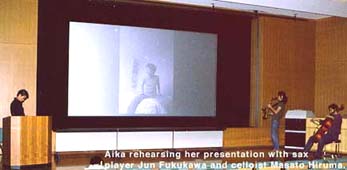
PhotoGuide Japan organized and held its very first public event called Tokyo International Photo Showcase 1999 (TIPS '99) on Oct. 23, 1999 at the Tokyo Metropolitan Museum of Photography Hall in Yebisu Garden Place, Tokyo. It was a slide show delivered by five Japan-based male and female photographers (three American and two Japanese). The purpose of this one-of-a-kind, English-speaking event was to showcase the work of talented photographers and to provide an opportunity for people (especially English speakers) interested in photography to gather and meet. From 2 p.m. to 5 p.m. on that sunny, balmy Saturday afternoon, up to 136 people of various nationalities and age brackets filled the nice, 190-seat hall in Japan's largest photography museum.

The five photographers who showed their work were Wynn White, Janet Leigh Foster, Lawrence Huff, Utako Minamino, and Aika Yamazaki. Each artist had lived in a foreign country (including Japan), and their overseas experience was amply reflected in their work. Their photography themes were also very personal or private in nature.
PhotoGuide Japan rented the hall for the event and it turned out to be a very appropriate venue well received by everyone. The same hall is used for many major photography events held by the museum and other photography-related organizations. TIPS '99 was totally independent and not an activity of the museum. Admission was free. Read on to learn more about what went on at TIPS '99.
|
|
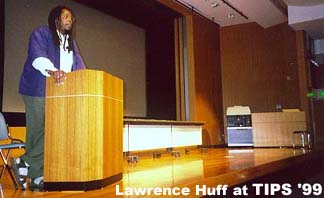
TIPS '99 opened with Jun Fukukawa, a friend of Aika Yamazaki, playing his saxophone on stage for a few minutes to call in the audience. The program started late at 2:25 p.m. when PhotoGuide Japan's Philbert Ono, serving as the MC, greeted the audience without introducing himself (too shy). He explained that they were doing this for the first time and begged the audience to "bear with us" if anything went wrong (fortunately, nothing major went wrong).
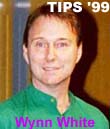 Phil then called the five photographers to the stage (see photo above) and introduced them individually in decent English and flawed Japanese. After Phil's rambling introductions (totally unrehearsed and unprepared) of the five artists, Wynn White started his 35-min. slide presentation of B/W photos of highly personal themes concerning his upbringing in Idaho and Oregon (where he had a lot of Japanese-American friends who got him interested in Japan), the work by photographers (Paul Strand, Eikoh Hosoe, and others) he admired, his first contact with Japan through the Navy, his Japanese wife and kids, and hometown in the US. He showed about 100 slides while Phil sometimes asked questions about the photos and interpreted into Japanese. See a sample photo here.
Phil then called the five photographers to the stage (see photo above) and introduced them individually in decent English and flawed Japanese. After Phil's rambling introductions (totally unrehearsed and unprepared) of the five artists, Wynn White started his 35-min. slide presentation of B/W photos of highly personal themes concerning his upbringing in Idaho and Oregon (where he had a lot of Japanese-American friends who got him interested in Japan), the work by photographers (Paul Strand, Eikoh Hosoe, and others) he admired, his first contact with Japan through the Navy, his Japanese wife and kids, and hometown in the US. He showed about 100 slides while Phil sometimes asked questions about the photos and interpreted into Japanese. See a sample photo here.
Next up was Janet Leigh Foster who started by explaining, "My passion for Japan grew out of my childhood experience of Japanese fairy tales. The animistic stories that included animals able to transform themselves thrilled me, but it was the illustrations above all that captured my imagination. My favorite book, long since lost and out of print, was Taro the Dragon Boy. Taro was a foundling who was raised by a female dragon. Not having milk to feed him, she gave him her eyeballs to eat. The dragon's eyeball was so big, the baby had to hold it with both hands. The concept of ingesting a dragon's eyeball fascinated me. I wondered if after eating it I would be able to see everything that the dragon-host had ever seen, projected like a technicolor film over mundane reality. I love to wander through Tokyo and photograph what I see through the eyes of the dragon. I invite the audience to imagine for themselves: If you ate a dragon's eyeball and could see everything that the dragon had ever seen, what would that be?"
She then showed her hand-colored (with permanent-ink pens) photographs of places in Tokyo such as temples, gravestones and cemetaries, Buddhas, and a white heron dance in Asakusa, Tokyo. See a sample photo here.
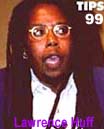 The third presentation was by Lawrence Huff who took 15 min. to show slides of his platinum prints of still lifes and nudes. At age 10, he had a cousin stationed in Okinawa who kept writing about how great Japan was. Lawrence thereby got interested in Japan and eventually took up karate (now a black belt) and even the shakuhachi. But he always wanted to be an artist and took a workshop conducted by Ansel Adams. The objects he photographs are very personal to him--things that he finds, gifts from friends, or objects in a friend's home. His favorite subject is nudes and he showed quite a few of them. After the slides, he invited the audience to view his prints already laid on three tables on the stage. The audience took advantage of the intermission which followed to do just that. See a sample photo here.
The third presentation was by Lawrence Huff who took 15 min. to show slides of his platinum prints of still lifes and nudes. At age 10, he had a cousin stationed in Okinawa who kept writing about how great Japan was. Lawrence thereby got interested in Japan and eventually took up karate (now a black belt) and even the shakuhachi. But he always wanted to be an artist and took a workshop conducted by Ansel Adams. The objects he photographs are very personal to him--things that he finds, gifts from friends, or objects in a friend's home. His favorite subject is nudes and he showed quite a few of them. After the slides, he invited the audience to view his prints already laid on three tables on the stage. The audience took advantage of the intermission which followed to do just that. See a sample photo here.
 After the 20-min. intermission, 24-year-old Utako Minamino showed the work she produced in high school and college (in Pennsylvania). Before taking up photography while in college, she started out drawing with pen and ink and dabbled in metal sculpture. She was bilingual in English and Japanese and sometimes was afraid of her words being misunderstood. She carved her message in woodcut patterns but left them incomprehensible. The actual words weren't important, but she wanted to show that she wanted to communicate something. She combined the woodcut patterns (transferred to rice paper) with mainly self-portraits and produced the results she wanted. She spoke in both English and Japanese to the relief of the MC who had been serving as a partial interpreter for the substantial Japanese audience. See a sample photo here.
After the 20-min. intermission, 24-year-old Utako Minamino showed the work she produced in high school and college (in Pennsylvania). Before taking up photography while in college, she started out drawing with pen and ink and dabbled in metal sculpture. She was bilingual in English and Japanese and sometimes was afraid of her words being misunderstood. She carved her message in woodcut patterns but left them incomprehensible. The actual words weren't important, but she wanted to show that she wanted to communicate something. She combined the woodcut patterns (transferred to rice paper) with mainly self-portraits and produced the results she wanted. She spoke in both English and Japanese to the relief of the MC who had been serving as a partial interpreter for the substantial Japanese audience. See a sample photo here.
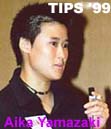 The last presentation was by Aika Yamazaki who talked briefly and then had saxophonist Jun Fukukawa and celloist Masato Hiruma performing on stage in reaction to her slides of six individual women in private situations (in the toilet, bath, etc.). The women were all non-Japanese either in France where she studied or in Tokyo. See a sample photo here.
The last presentation was by Aika Yamazaki who talked briefly and then had saxophonist Jun Fukukawa and celloist Masato Hiruma performing on stage in reaction to her slides of six individual women in private situations (in the toilet, bath, etc.). The women were all non-Japanese either in France where she studied or in Tokyo. See a sample photo here.
Although the program started late, it ended on time at 5 p.m. In his closing remarks, Philbert held back his tears and thanked everyone for coming and acknowledged everyone who helped with TIPS '99. On behalf of the five artists, Wynn White also thanked Phil for providing the opportunity. The program was then declared over.
Later from 6 p.m. to 8 p.m., there was a party at a nearby beer hall in Yebisu Garden Place and about 20 people, including the five photographers, rejoiced over the success of TIPS '99.
See also: Artist Bios & Works
|
|
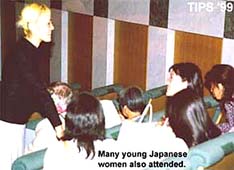
We were delighted to see an audience of 136 by mid-afternoon. No one expected this many to come. It was an international crowd of Japanese and foreigners ranging from hip Japanese women in their 20s to elder foreign gentlemen. (A few children were also present.) The Japanese audience was very attentive and there was no fidgeting regardless of the mainly-English format. Everyone applauded often and it was a very receptive crowd. Although some people had to leave early, the majority was able to stay until the end of the program at 5 p.m. We were fortunate to have such a great audience.
A few comments from the audience:
"I was surprised to see how nice the actual prints were after seeing Lawrence's slides which did not do them justice."
"I can't believe the first guy (Wynn White) showed his baby photos!"
"Everyone's work was so original and unique."
"The hall was really nice."
"When I walked into the hall, it was so nice that I got the feeling that something good was going to happen."
"The place was packed. I think there were more Japanese than foreigners."
"When we came late, it was hard to find empty seats."
"There's always things that can be improved, but it was good."
"It was good."
"Utako's images on the postcards looked haunting and ghostlike."
"I enjoyed Aika's presentation even though I didn't think the images were that powerful. But I shouldn't say that I enjoyed the live music more than the photographs."
"Utako was the shy type, and her work was really heavy, combining text and images both of which are used for communication."
"Phil, you shouldn't refer to adult women as 'girls.' It's not politically correct these days."
"Next time, you should have a separate person to be the MC and interpreter. You were doing everything."
"Phil, you are going great! Thank you for sending the program for TIPS '99; I couldn't go, but I really hand it to you--such a professional job and I'm so glad you had such a good turn out!"
Next: TIPS 1999 Artists
Copyright © 1999 Philbert Ono. All rights reserved.
Transmitting from Tokyo, Japan.